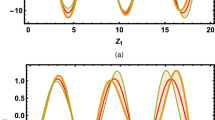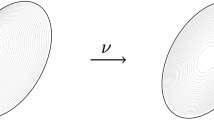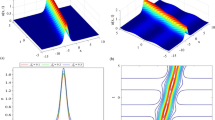Abstract
Based on an asymptotic analysis of the compressible Navier–Stokes equations, the basic concept of the Multiple Pressure Variables (MPV) approach is to split up the pressure into three different terms representing global background effects, acoustic waves and the incompressible pressure, respectively. Special attention is payed to aeroacoustic phenomena and the numerical treatment of the generation and spreading of sound waves. To this aim, further perturbation analysis is done about the incompressible limit solution. This gives hints how to extract acoustic waves responsible for the noise generation from the flow field.
Similar content being viewed by others
References
Klainerman S., Majda A. (1981) Singular limits of quasilinear hyperbolic systems with large parameters and the incompressible limit of compressible fluids. Comm. Pure Appl. Math. XXXIV, 481–524
Klein R. (1995) Semi-implicit extension of a Godunov-type scheme based on low Mach number asymptotics I: One dimensional flow. J. Comput. Phys. 121, 213–237
Lee D., Koo S. (1995) Numerical simulation of sound generation due to a spinning vortex pair. AIAA J. 33, 20–26
Millington R., Toro E., Nejad L.: Arbitrary high order methods for conservation laws I: the one dimensional scalar case. PhD Thesis, Manchester Metropolitan University, Department of Computing and Mathematics (1999)
Mitchell B.E., Lele S.K., Moin P. (1995) Direct computation of the sound from a compressible co-rotating vortex pair. J. Fluid Mech. 285, 181–202
Roller S., Munz C.-D. (2000) A low Mach number scheme based on multi-scale asymptotics. Comput. Vis. Sci. 3, 85–91
Schwartzkopff T., Dumbser M., Munz C.: Caa using domain decomposition and high order methods on structured and unstructured meshes. In: 10th AIAA/CEAS Aeroacoustic Conference, Manchester, (2004)
Schwartzkopff T., Dumbser M., Munz C. (2004) Fast high order ADER schemes for linear hyperbolic equations. J. Comput. Phys. 197, 532–539
Schwartzkopff T., Munz C., Toro E., Millington R.: The ader approach in 2d for a system of linear hyperbolic pdes. In: Sonar T. (ed.) Proceedings of GAMM workshop on ’Discrete Modelling and Discrete Algorithms in Continuum Mechanics’. p. 10. Logos, Berlin, (2001)
Tam C.K.W., Webb J.C. (1993) Dispersion-relation-preserving finite difference schemes for computational acoustics. J. Comput. Phys. 107, 262–281
Toro E., Millington R.: Ader: high-order non-oscillatory advection schemes. In: Proceedings of the 8th International Conference on Nonlinear Hyperbolic Problems. preprint, 2000
Author information
Authors and Affiliations
Corresponding author
Additional information
Communicated by G. Wittum.
This work has been supported by Deutsche Forschungsgemeinschaft (DFG).
Rights and permissions
About this article
Cite this article
Roller, S., Fortenbach, R., Schwartzkopff, T. et al. The numerical modeling of acoustic wave propagation using the multiple pressure variables approach. Comput. Visual Sci. 9, 229–237 (2006). https://doi.org/10.1007/s00791-006-0026-9
Received:
Accepted:
Published:
Issue Date:
DOI: https://doi.org/10.1007/s00791-006-0026-9




